|

fabrics
& sewing
basic
medieval
clothing
sewing
tutorials
eyelet
tutorial
buttonhole
tutorial
cloth
button
tutorial
lucet
cord
tutorial
tassel
tutorial

|

Sewing
Tutorial:
Early 13th Century Medieval Gown With Wide Sleeves
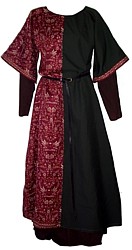
Re-enactors use a slightly
more complicated pattern with underarm gores and a separate sleeve,
but to make a slightly cheaty one which requires less sewing,
you can cut it all in one piece. Made out of silk or cotton velveteen
and it's gorgeous for feasts and you can see that a particolour
gown makes a plain pattern a bit more fancy!
This can not be worn alone. It should be worn with tight sleeves
covering your bare arms. If you choose to make the shorter sleeve
and hem, you definately should have another gown underneath.
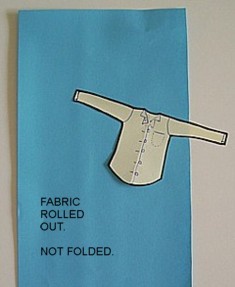 |
Step
1
You need: your fabric, pins, scissors and a cotton shirt for
sizing.
Don't use a stretchy one as it can give a false sense of how
it will fit you.
If you don't have a cotton shirt, get thee to an Op Shop and
spend a couple of dollars and get one. |
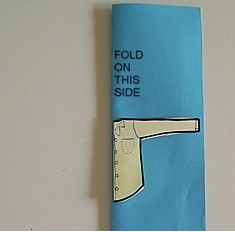 |
Step 2
Fold your shirt and your fabric in half lengthways.The good
side of the fabric is on the inside.
If you arm goes to the edge of the fabric, HOORAY, you can
make this with very little fabric at all. If your fabric
is skinny, you will need to fold your fabric double (two
runs of fabric instead of a folded over piece) before you
begin.
Your folded shirt matches the side with the folded fabric.
|
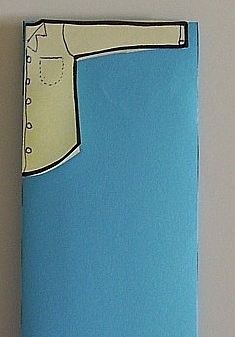 |
Step
3
Fold your long, skinny folded fabric again the other way so
you have one fold where your shirt centre fold is and one
fold at the top of the sleeve.
You should have your one piece of fabric folded in four and
the shirt in the top left hand corner where the fold is. The
loose sides are to the right and to the bottom.
Not sure what I mean?
Check the next picture to double check that you've folded
it right. |
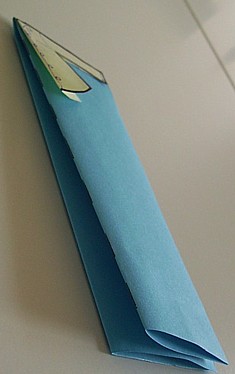 |
Step
4
Looking at it from a different angle to double check you've
folded your fabric the right way before you pin or cut anything.
Your loose corners are at the bottom right.
Your corner fold where everything meets is at the top left
where your head hole is.
Your shirt is sitting right in that corner ready to mark out
your dress.
All good? Right! Let's continue. |
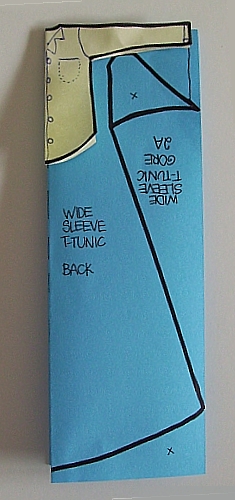 |
Step 5
Marking out your pattern. This is not as hard as it sounds.
Always ALWAYS cut the seams a bit bigger than you think
you need. You can always take a dress in but it's really
hard to add pieces in once it's cut. Your pattern is based
around your non-stretchy shirt.
Because it pulls on over the head, you need to allow extra
room at the sides.
The underarm curves up and the sleeve follows your shirt
to the elbow and then down to the edge of the fabric to
about waist height. Your seam is on the fabric edge and
doesn't even need hemming!
To get the size of your skirt, draw a line from the hip
(the bottom of the shirt) to the very edge of the fabric.
The wider your fabric, the more skirt you'll have. Your
centre seam is as long as you are to the ground.
You will notice that with a smaller sleeve, you now have
fabric to cut two triangles called "gores."
Just double check again that the fabric is folded the right
way before you pin anything... it should look like this...all
the loose corners are in the lower right hand side?
.. okay, start pinning!
|
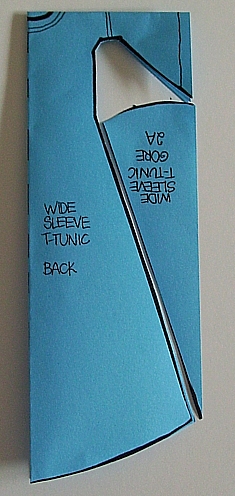 |
Step
6
Now you've pinned, you can cut out your new gown.
okay.. snip snip!
Cut your new dress out.
It will look like this. |
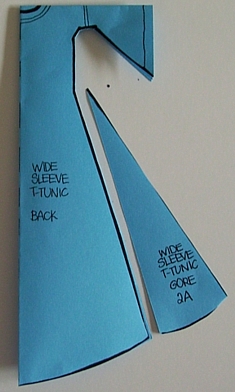 |
Step
7
Unpin the sides now that your dress is cut.
Swing the triangle gore around so it sits with the top of
the triangle gore at the waist and the bottom of the gore
at the hem of your dress.
It looks like this. |
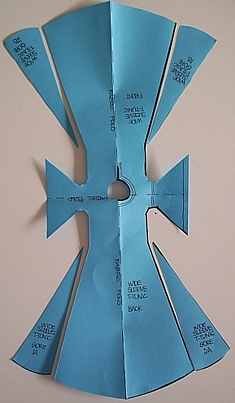 |
Step 8
Unfold your dress altogether.
When it's spread out of the floor, it looks like this. Make
sure your triangle gores are sitting evenly- eg raw cut
side of fabric towards the raw cut side of the dress body
and all the selvedges on the outside of the dress.
Now get to work pinning those gores onto the body of the
dress. Good side of the fabric on the inside.
Depending on the size of the fabric you started with, the
gores may be a little big. That's ok. Start the top of the
gore at waist height. You will be able to trim the hem down
later. (Or it you want the hem to be as big as possible,
just trim the top of the triangle gore so it doesn't go
as high. This can be a bit fiddley for first-timers, so
you might want to not do that.)
At this point, it's exactly the same front and back. Choose
the side you want to be the front and cut the neckline a
little lower. Just a little. Remember, you can take more
off, but it's really hard to put it back on. Okay so now
you have a front. The seam with the dotted line running
horizontally through the neckline is where you fold your
dress now.
|
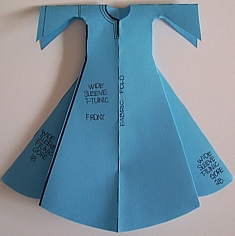 |
Step 9
If you've folded correctly, you now have a dress which looks
like this. Remember, the good sides of the fabric are on
the inside.
Pin, pin, pin those
side seams all the way from the hem, along the body, under
the arms and down the sleeves. Now very, very carefully
check you can get it on over your head. If it's very loose
through the body, take the side seams in a little. Try it
on again. Still loose? Pin in again and try it on. Remember,
it will be a little loose so you can pull it on over your
head.
Once you're happy with the fit and you've adjusted your
neckline, sew your two side seams and you're finished!
|
|
|
The
finished result
Your new gown will hang like a sack a little at first, but
don't be depressed. When you put your belt on, it will pull
in at the waist like it does in medieval manuscripts. Add
a pretty hood and pouch and you're all dressed!
You can add finishing coloured bands at the bottom of the
hem and around the sleeves cuufs and neckline.
We made this gown in a particolour in wool with bands which
were cut off the original patterned wool.
Happy sewing! |

Copyright
© Rosalie Gilbert
All text & photographs within this site are the property of
Rosalie Gilbert unless stated.
Art & artifact images remain the property of the owner.
Images and text may not be copied and used without permission.
|